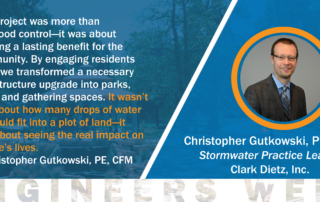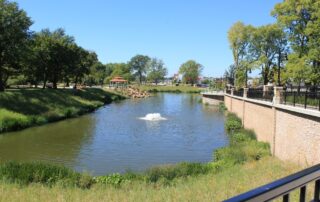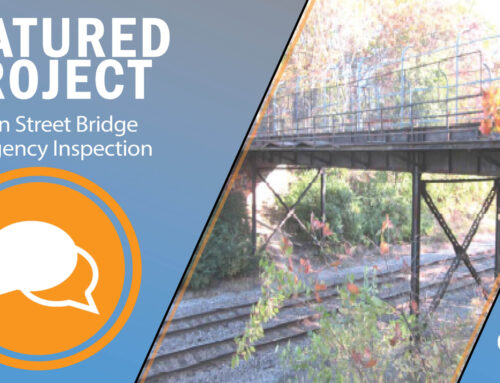What if stormwater infrastructure could do more than just manage runoff? What if it could enhance a community, provide new public spaces, and redefine how we think about urban infrastructure?
That’s exactly what happened in Champaign, Illinois, where a project that started as a flood mitigation effort evolved into a model for resilient, community-focused stormwater design.
With the expertise of Christopher Gutkowski, PE, CFM, and our incredible Clark Dietz team, along with the City of Champaign’s vision, what began as a solution to drainage problems became two new parks, recreational trails, and a reimagined neighborhood landscape.
This is the story of how engineering isn’t just about pipes and basins—it’s about people, place, and the power of great design.
Rethinking Stormwater: From Infrastructure to Community Asset
Traditionally, stormwater projects focus solely on flood mitigation. However, under Chris’s leadership and the collaboration of the Clark Dietz team, the West Washington Street project adopted a holistic approach.
“We included the neighborhood early in the process to see how it can be a benefit to the community rather than just a solution to the problem,” Chris explains. This philosophy transformed standard infrastructure into vibrant public spaces, aligning with our commitment to engineering quality of life.
Project Overview
Initiated in 2009, the project addressed chronic flooding in the West Washington Street watershed, primarily caused by an undersized storm sewer system. The comprehensive plan unfolded in three phases:
-
Phase I: Construction of an 11-acre-foot detention basin at Preservation Pond, providing approximately 28% of the required 40-acre-foot storage to achieve a 40-year flood protection level. This phase also included storm sewer enhancements and the addition of park-like amenities such as multi-purpose paths, a gazebo, benches, ornamental lighting, and rain gardens.
-
Phase II: Development of two new detention basins at the Glenn Park Drive site, further bolstering flood protection. The project encompassed a complete street overhaul with new pavement, sidewalks, and driveways, alongside the integration of recreational features.
-
Phase III: Installation of 5,500 feet of new sewers and lining of 5,100 feet of existing sewers to channel stormwater to the new basins. This phase also introduced bioswales and ten rain gardens to enhance runoff storage and improve water quality in the Copper Slough Channel.
Engineering with Empathy
For Chris, the project’s impact transcended technical achievements. “Seeing the impact on the residents—the flooding was affecting them—put a face to the problem,” he reflects. But the true measure of success came not just in data, but in a handwritten letter from a resident, thanking him for his work.
“This project was more than just flood control—it was about creating a lasting benefit for the community,” Chris says. “By engaging residents early, we transformed a necessary infrastructure upgrade into parks, trails, and gathering spaces. It wasn’t just about how many drops of water we could fit into a plot of land—it was about seeing the real impact on people’s lives.”
The project’s success is a testament to collaborative engineering, public engagement, and a vision that prioritized both function and community benefit.
Collaborative Vision
The success of the project is a testament to the collaborative efforts between Clark Dietz, the City of Champaign, and the local community. “The City of Champaign and the neighborhood helped steer the project in the direction of what can we do to better the area while we’re doing this,” Chris notes. The evolution from a singular flood mitigation effort to the creation of two community parks exemplifies this shared vision.
Meet the Engineer: Christopher Gutkowski, PE, CFM
Engineering wasn’t always the plan for Christopher Gutkowski, PE, CFM—but a passion for problem-solving and infrastructure led him to where he is today. Originally studying physics, he pivoted to civil and environmental engineering, drawn in by an incredible stormwater course that became one of his most memorable classes. That passion led him to earn his master’s degree in stormwater engineering, deepening his expertise in flood mitigation, water quality, and sustainable infrastructure.
Growing up, Chris had a natural fascination with bridges and the built environment, influenced by an uncle who was a civil engineer. Now, as a Stormwater Practice Leader at Clark Dietz, he leads stormwater projects across the Midwest, collaborating with diverse teams and navigating the unique challenges of different states, regulations, and software systems.
Reflecting on the West Washington Street Drainage Improvements, Chris says this project was transformational—not just for the community, but for his own growth as an engineer. Starting the study just five years into his career, it quickly became more than just numbers and calculations.
“This project helped me become a better engineer,” he shares. “It wasn’t just about how many drops of water we could fit into a plot of land—it was about seeing the real impact on people’s lives.”
Recognized Excellence
The innovative approach of this project has been recognized with multiple awards, including:
- 2015 APWA Environment (Less than $5 Million) Award for Phase I
- 2019 APWA Illinois Project of the Year
- 2021 ACEC Illinois Engineering Excellence Special Achievement Award
- 2021 ACEC Illinois Judges Choice Award
These awards reflect not only the project’s technical excellence but also its lasting community impact.
Learn More
For a deeper dive into each phase of the project, visit our detailed project pages:
- West Washington Street Drainage Improvements, Phase I
- West Washington Street Watershed Drainage Improvements & Community Green Space
We also encourage you to explore past blogs for additional insights:
- Champaign’s 20-Year Stormwater Journey
- 2021 ACEC IL Judges Choice Award Accepted by Clark Dietz, Inc.
This project exemplifies how thoughtful engineering can address infrastructure challenges while enriching community spaces, embodying our mission to engineer quality of life.




























